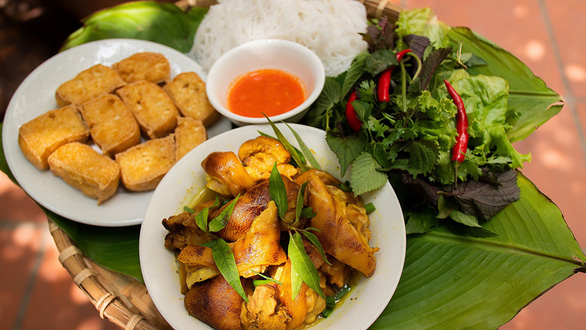When the cool spring breeze starts blowing and it is not too hot to handle, the weather is just perfect to pique my craving for gia cay (fake dog meat).
The dish earns its name as 'fake' dog meat because it uses the same technique of processing dog meat, however, replaces the meat with pork.
The culinary techniques behind the dish, the combination of herbs and spices, and the aroma and texture make it worth giving a try.
I opt for three to four short, meaty trotters with pretty firm skin to secure the chewy texture later on.
The ratio of meat and fat should be well balanced as one will not want their stew to look oily and taste bland.
Grilling makes a name for gia cay
I put all my faith in a butcher at Giap Nhat Market in Hanoi’s Thanh Xuan District when it comes to cooking gia cay.
She always helps me with grilling pettitoes.
Simple as the technique might look, it actually requires chopping each foot into half and then slightly cut each piece into three.
It is of importance to use rice straw to grill, giving off a smoky smell and the yellowish umber color for pork skin.
The procedure takes time, of course but I am willing to pay a little more, knowing that the final dish will be full of umami and flavors.
Grilling decides the quality of gia cay.
The two best ways are over hot charcoal or smoking hot rice straw.
For some gia cay enthusiasts, nothing can beat covering trotters with freshly dried rice straw then broiling them.
The butcher also helps to chop pig's feet into bite sizes after grilling them in a skilful manner that an amateur like me cannot do.
Pettitoes are shaved to remove burned bits before cleaning thoroughly.
Each piece has to consist of skin, lean and fat – well harmonized when the dish is served in small portions.
Meat then is marinated with generous amounts of galangal, fermented rice, turmeric juice, shallot, salt, and shrimp paste for a couple of hours.
It tastes even better if meat is left cured in spices overnight.
Good things take time, especially for gia cay.
Flipping it up, not stir-frying
Gia cay is an authentic Vietnamese food with indigenous ingredients and a traditional cooking style.
I heat up my pan, put pork in then flip it well without using oil.
Flipping – as my mom stressed time over time – will help to lock up the marinade.
Fresh bamboo shoots, chopped small, have to be washed, rinsed, cooked then marinated with the same spices used for the trotters.
I put bamboo shoots into the pan and flip them well with pork for a while.
Some old wise men told me that people had just cooked gia cay with bamboo shoots for some 50 years so it must not have been so traditional.
I wonder whether it is true or not but my friends like to have bamboo shoots stewed with pork for a lighter, more digestible dish.
Many of them even prefer bamboo shoots to pork as those crunchy pieces absorb the soup, making each bite an umami boom.
After a while, I pour water in, just slightly over pork and bamboo shoots, boil it up then reduce heat to stew in about 20 minutes.
If one wants it to be a little more tender, keep the pan being stewed in additional 15 minutes.
For me, I love the chewy texture of pork skin, so tempting that I definitely pair it with a cup of rice wine. Eating slowly and having a sip now and then, that is how I enjoy gia cay.
Herbs could not be missed. Thinly sliced green onion and laksa leaves are a must.
However, to upgrade the whole culinary experience, gia cay should be eaten with a feast of greens, namely salad, perilla, marjoram, coriander, basil, and cilantro.
A small bunch of vermicelli or some scoops of rice dashed with a spoonful of fatty yellow broth sprinkled with green onion are just too tempting to wait.
My taste buds dance happily in the harmony of taste, texture, and fragrance, craving for more and more.
Gia cay used to be an exclusive dish for important events – home parties or death ceremonies when the whole family gathered.
During Tet (Vietnamese Lunar New Year) holiday, some families even have it prepared and frozen for a little festive touch in normal meals.
The dish was generalized and started appearing at some Hanoi local eateries. There are restaurants serving only gia cay with vermicelli, too.
I think, just like me, a lot of people have grown their love for the one and only gia cay.
* This article was first published in Vietnamese at tuoitre.vn under the byline of Vu Thi Tuyet Nhung. Khoa Thu from Tuoi Tre News translated it into English.
Like us on Facebook or follow us on Twitter to get the latest news about Vietnam!



























